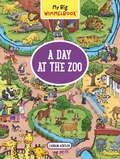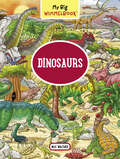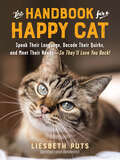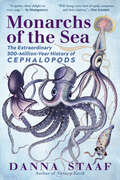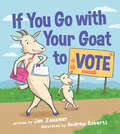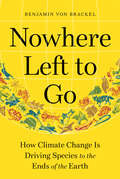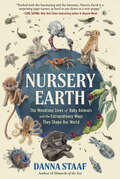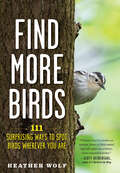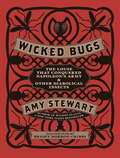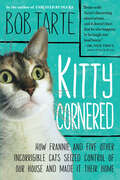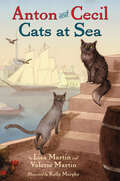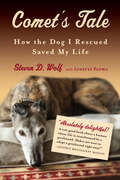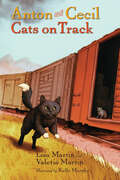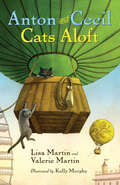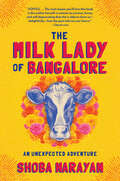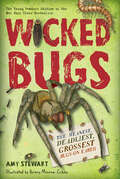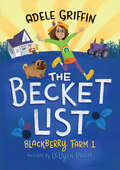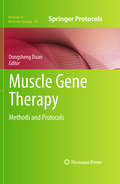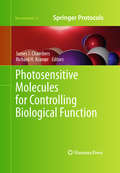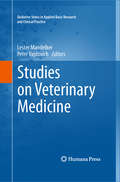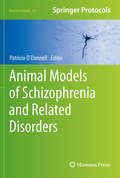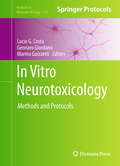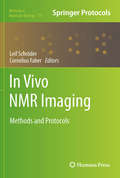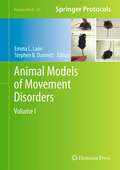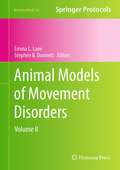- Table View
- List View
My Big Wimmelbook—A Day at the Zoo: A Look-and-Find Book (Kids Tell the Story) (My Big Wimmelbooks)
by Carolin GörtlerA book for beginning readers, chock-full of vibrant illustrations that tell stories without the use of words, depicting characters exploring the zoo—with exhibits ranging from the Africa savanna to the Arctic tundra.
My Big Wimmelbook—Dinosaurs (My Big Wimmelbooks)
by Max WaltherWelcome to Wimmelworld—a land of few words, yet endless entertainment—for curious kids age 2 to 5!
The Handbook for a Happy Cat: Speak Their Language, Decode Their Quirks, and Meet Their Needs—So They'll Love You Back!
by Liesbeth PutsGive your best friend more purr and pounce with this whiskers-to-tail guide to the good life! One reason we&’re wild for cats is that our cats are still wild at heart. On our laps, they&’re purring lovebugs, but on the prowl, they&’re fearsome hunters—with territorial instincts to match.The Handbook for a Happy Cat takes us inside the feline mind to decode what our cats really want in life and how they try to tell us. You&’ll learn:Why a bigger water bowl does away with &“whisker stress&”How to move like a mouse for maximum fun at playtimeSkills to teach your kitten for a lifetime of easy vet visits, grooming, and moreSubtle signs of stress such as excessive scent-marking and lip-lickingHow to tell frolic from fighting in the multi-cat household (and how to give frenemies a fresh start)What makes a scratching post so tempting that your sofa will be sparedHow to reassure a spooked cat with the &“slow blink&”Why it&’s pointless to &“punish&” a cat—but training is possible! Certified behaviorist Liesbeth Puts traces every feline mystery to cats&’ natural behavior and needs. A happy cat is a cat who can be herself!
Monarchs of the Sea: The Extraordinary 500-Million-Year History of Cephalopods
by Danna StaafAn epic evolutionary history of cephalopods: from the ancient mollusks that invented swimming five hundred million years ago, to the octopuses, squid, and other inscrutably intelligent animals of today
If You Go with Your Goat to Vote
by Jan ZauzmerWith their adorable babies in tow, an eclectic menagerie of animals visit the polls and vote—teaching young readers how voting works, and reminding grown-ups to model civic engagement for the next generation
Nowhere Left to Go: How Climate Change Is Driving Species to the Ends of the Earth
by Benjamin von BrackelHarrowing journeys of animals and plants—fleeing skyrocketing temperatures and mega-droughts—reported from the front lines of the biggest migration of species since the Ice Age
Nursery Earth: The Wondrous Lives of Baby Animals and the Extraordinary Ways They Shape Our World
by Danna StaafFrom the author of Monarchs of the Sea, a first-of-its-kind journey into the hidden world of baby animals—hailed as &“a gobsmacking delight!&” (Sy Montgomery, New York Times–bestselling author of The Soul of an Octopus) It&’s time to pay attention to baby animals. From egg to tadpole, chick to fledgling, they offer scientists a window into questions of immense importance: How do genes influence health? Which environmental factors support—or obstruct—life? Entire ecosystems rest on the shoulders (or tentacles, or jointed exoskeletons) of animal babies. At any given moment, babies represent the majority of animal life on Earth. In Nursery Earth, researcher Danna Staaf invites readers into the sibling (and, sometimes, clashing) fields of ecology and developmental biology. The tiny, hidden lives that these scientists study in the lab and in the wild reveal some of nature&’s strangest workings: A salamander embryo breathes with the help of algae inside its cells. The young grub of a Goliath beetle dwarfs its parents. The spotted beak of a parasitic baby bird tricks adults of other species into feeding it. Mouse embryos can absorb cancerous cell grafts—and develop into healthy adults. Our bias toward adult animals (not least because babies can be hard to find) means these wonders have long gone under-researched. But for all kinds of animals, if we overlook their babies, we miss out on the most fascinating—and consequential—time in the lives of their species. Nursery Earth makes the case that these young creatures are not just beings in progress but beings in their own right. And our planet needs them all: the maggots as much as the kittens!
Find More Birds: 111 Surprising Ways to Spot Birds Wherever You Are
by Heather Wolf&“Packed with excellent photos and tips, deeply relatable anecdotes, and a palpable sense of joy, this gem of a book will make you a better birder.&”—Rosemary Mosco, author of A Pocket Guide to Pigeon Watching A gorgeously photographed trove of 111 ingenious tips for seeing more birds wherever you are—from crowd favorites (hummingbirds, owls, eagles) to species you&’ve never spotted before Seeing more birds than you ever imagined and witnessing exciting avian drama is possible—whether you&’re on the go or in your own neighborhood, local park, or backyard. As Heather Wolf explains, it all comes down to how you tune in to the show happening around you, the one in which birds—highly skilled at staying under the radar—are the stars. In Find More Birds, Heather shares her very best tactics—and the jaw-dropping photographs they helped her capture. Look for birds at their favorite &“restaurants&”— from leaf litter to berry bushes, and ball fields to small patches of mud. Watch for &“tree bark&” that moves . . . you may find it has feathers. Try simply sitting on the ground for a revealing new perspective. Plus, special tips point the way to crowd favorites such as hummingbirds, owls, and eagles—and can&’t-miss bird behaviors. As your senses sharpen and &“noticing&” becomes second nature, Find More Birds will turn your daily routines into bird-finding adventures, too. Whether you&’re strolling down the block or parking your car, you never know what will surprise you next!
Wicked Bugs: The Louse That Conquered Napoleon's Army & Other Diabolical Insects
by Amy StewartIn this darkly comical look at the sinister side of our relationship with the natural world, Stewart has tracked down over one hundred of our worst entomological foes—creatures that infest, infect, and generally wreak havoc on human affairs. From the world&’s most painful hornet, to the flies that transmit deadly diseases, to millipedes that stop traffic, to the &“bookworms&” that devour libraries, to the Japanese beetles munching on your roses, Wicked Bugs delves into the extraordinary powers of six- and eight-legged creatures. With wit, style, and exacting research, Stewart has uncovered the most terrifying and titillating stories of bugs gone wild. It&’s an A to Z of insect enemies, interspersed with sections that explore bugs with kinky sex lives (&“She&’s Just Not That Into You&”), creatures lurking in the cupboard (&“Fear No Weevil&”), insects eating your tomatoes (&“Gardener&’s Dirty Dozen&”), and phobias that feed our (sometimes) irrational responses to bugs (&“Have No Fear&”). Intricate and strangely beautiful etchings and drawings by Briony Morrow-Cribbs capture diabolical bugs of all shapes and sizes in this mixture of history, science, murder, and intrigue that begins—but doesn&’t end—in your own backyard.
Kitty Cornered: How Frannie and Five Other Incorrigible Cats Seized Control of Our House and Made It Their Home
by Bob TarteKitty Cornered is raucous and witty and as heartwarming as a basket of kittens. I&’m a bone-i-fied dog lover, but this book settles it: I&’m getting a cat, or six.&” —Dan Dye, author of Amazing Gracie Bob Tarte had his first encounter with a cat when he was two and a half years old. He should have learned his lesson then, from Fluffy. But as he says, &“I listened to my heart instead, and that always leads to trouble.&” In this tell-all of how the Tarte household grew from one recalcitrant cat to six—including a hard-to-manage stray named Frannie—Tarte confesses to allowing these interlopers to shape his and his wife&’s life, from their dining habits to their sleeping arrangements to the placement and furriness of their furniture. But more than that, Bob begins seeing Frannie and the other cats as unlikely instructors in the art of achieving contentment, even in the face of illness and injury. Bewitched by the unknowable nature of domesticated cats, he realizes that sometimes wildness and mystery are exactly what he needs. With the winning humor and uncanny ability to capture the soul of the animal world that made Enslaved by Ducks a success, Tarte shows us that life with animals gives us a way out of our narrow human perspective to glimpse something larger, more enduring, and more grounded in the simplicities of love—and catnip.
Anton and Cecil, Book 1: Cats at Sea (Anton and Cecil #1)
by Lisa Martin Valerie MartinWhen Anton is stolen off the dock, the next thing he knows, he&’s at sea. Knowing little of the wide open ocean, brave Cecil boards another ship to find his brother. But what begins as a rescue mission turns into a pair of high seas adventures, with thrills and danger bubbling under every wave.
Comet's Tale: How the Dog I Rescued Saved My Life
by Steven Wolf Lynette PadwaComet’s Tale is a story about a friendship between two former winners, both a little down on their luck, who together stage a remarkable comeback. A former hard-driving attorney, Steven Wolf has reluctantly left his job and family and moved to Arizona for its warm winter climate. There he is drawn to a local group that rescues abused racing greyhounds. Although he can barely take care of himself because of a spinal condition, Wolf adopts Comet, an elegant cinnamon-striped racer. Or does Comet adopt Wolf? In Comet’s Tale we follow their funny and moving journey as Wolf teaches Comet to be a service dog. With her boundless enthusiasm and regal manners, Comet attracts new friends to Wolf’s isolated world. And finally, she plays a crucial role in restoring his health, saving his marriage, and broadening his definition of success.
Anton and Cecil, Book 2: Cats on Track (Anton and Cecil #2)
by Lisa Martin Valerie MartinThe adventurous cats who sailed the open seas in Anton and Cecil: Cats at Sea head west by train to rescue a missing mouse friend. With few clues, the two depend on the help of prairie dogs, bison, ferrets, and a wise lynx to solve the mystery of Hieronymus&’s whereabouts.
Anton and Cecil, Book 3: Cats Aloft (Anton and Cecil #3)
by Lisa Martin Valerie MartinIn the thrilling final adventure of the critically acclaimed trilogy, cat brothers Anton and Cecil team up with a police dog to search for puppies stolen right off their leashes at the Chicago World&’s Fair.
The Milk Lady of Bangalore: An Unexpected Adventure
by Shoba NarayanThe elevator door opens. A cow stands inside, angled diagonally to fit. It doesn&’t look uncomfortable, merely impatient. &“It is for the housewarming ceremony on the third floor,&” explains the woman who stands behind the cow, holding it loosely with a rope. She has the sheepish look of a person caught in a strange situation who is trying to act as normal as possible. She introduces herself as Sarala and smiles reassuringly. The door closes. I shake my head and suppress a grin. It is good to be back. When Shoba Narayan—who has just returned to India with her husband and two daughters after years in the United States—asks whether said cow might bless her apartment next, it is the beginning of a beautiful friendship between our author and Sarala, who also sells fresh milk right across the street from that thoroughly modern apartment building. The two women connect over not only cows but also family, food, and life. When Shoba agrees to buy Sarala a new cow, they set off looking for just the right heifer, and what was at first a simple economic transaction becomes something much deeper, though never without a hint of slapstick.The Milk Lady of Bangalore immerses us in the culture, customs, myths, religion, sights, and sounds of a city in which the twenty-first century and the ancient past coexist like nowhere else in the world. It&’s a true story of bridging divides, of understanding other ways of looking at the world, and of human connections and animal connections, and it&’s an irresistible adventure of two strong women and the animals they love.
Wicked Bugs (Young Readers Edition): The Meanest, Deadliest, Grossest Bugs on Earth
by Amy StewartDid you know there are zombie bugs that not only eat other bugs but also inhabit and control their bodies? There&’s even a wasp that delivers a perfectly-placed sting in a cockroach&’s brain and then leads the roach around by its antennae — like a dog on a leash. Scorpions glow in ultraviolet light. Lots of bugs dine on corpses. And if you want to know how much it hurts to get stung by a bullet ant (hint: it really, really hurts), you can consult the Schmidt Sting Pain Index. It ranks the pain produced by ants and other stinging creatures. How does it work? Dr. Schmidt, the scientist who created it, voluntarily subjected himself to the stings of 150 species. Organized into thematic categories (Everyday Dangers, Unwelcome Invaders, Destructive Pests, and Terrible Threats) and featuring full-color illustrations by Briony Morrow-Cribbs, Wicked Bugs is an educational and creepy-cool guide to the worst of the worst of insects, arachnids, and other arthropods. This is the young readers adaptation of Amy Stewart&’s bestselling book for adult readers.
The Becket List: A Blackberry Farm Story
by Adele GriffinYoung middle-grade readers coping with change in their own lives will wonder and explore with the bold and intrepid Becket Branch when her family&’s move from city to a country farm means big changes.
Muscle Gene Therapy: Methods and Protocols (Methods in Molecular Biology #709)
by Dongsheng DuanGene therapy offers many conceptual advantages to treat muscle diseases, especially various forms of muscular dystrophies; however, it faces a number of unique challenges, including the need to deliver a therapeutic vector to all muscles throughout the body. In Muscle Gene Therapy: Methods and Protocols, expert researchers in the field present a collection of techniques aimed at bridging the translational gap in muscle gene therapy between the prevalent rodent models and vitally important larger animal models. Divided into three sections, this volume examines basic protocols for optimizing the muscle gene expression cassette and for evaluating the therapeutic outcomes, new developments in muscle gene therapy technology such as adeno-associated viral vector (AAV), oligonucleotide-mediated exon-skipping, and novel RNA-based strategies, and step-by-step guidance on muscle gene delivery in swine, ovine, canine, and non-human primates. Written in the highly successful Methods in Molecular Biology™ series format, chapters include introductions to their respective topics, lists of the necessary materials and reagents, detailed, readily reproducible laboratory protocols, and tips on troubleshooting and avoiding known pitfalls. Authoritative and cutting-edge, Muscle Gene Therapy: Methods and Protocols serves as an invaluable resource for graduate students, post-doctoral fellows, and principle investigators pursuing the crucial advancement of muscle disease gene therapy in the hope of someday curing these debilitating disorders.
Photosensitive Molecules for Controlling Biological Function (Neuromethods #55)
by James J. Chambers and Richard H. KramerThe development of new photochemical tools, some synthesized by chemists and some provided by nature, is rapidly changing the way neurobiological research is performed in the modern laboratory. In Photosensitive Molecules for Controlling Biological Function, expert researchers in the field examine the most cutting-edge tools currently available. Divided into three sections, this detailed compendium features techniques involving natural photosensitive proteins, caged neurotransmitters, and small molecule photoswitches that bestow light sensitivity on ion channels and receptors. Written for the Neuromethods series, this volume features the type of meticulous description and implementation advice that is crucial for getting optimal results in the lab. Authoritative and practical, Photosensitive Molecules for Controlling Biological Function provides an unbiased comparison of the various photochemical tools currently available for controlling neuronal activity in order to aid scientists in the vital goal of choosing the right tools for the right job.
Studies on Veterinary Medicine (Oxidative Stress in Applied Basic Research and Clinical Practice)
by Lester Mandelker and Peter VajdovichThis compendium of research material on the role of oxidative stress in animal disease and morbidity examines both the general and the specific. Sourced from scientists, veterinarians, and members of the medical community from around the world, it includes chapters on our wider understanding of the corrosive function of free radicals in cell biology as well as focusing on the interplay between oxidative stress and metabolism in a variety of animal species including dogs, ruminants and birds. Since biogerontologist Denham Harman first posited that free radicals arising from the metabolic activity of oxygen play a central role in aging and disease, a mass of evidence has accumulated linking oxidative stress and biological degradation. We now understand that living in an aerobic environment inevitably leads to the production of free radicals that go on to attack biological membranes and lipoproteins via oxidation in a process called lipid peroxidation. Reacting with carbon-based molecules such as polyunsaturated fatty acids, these free radicals cause oxidative stress and tissue damage. The purpose of Studies on Veterinary Medicine is to inform clinicians, students and others of the plethora of consequences that free radical damage (ROS) has on various cells, tissues, and organs, as well as in different species of animals. The chapters also analyze the effects of oxidative stress on aging and various morbidities such as diabetes, cognitive dysfunction and heart disease. Contributors variously present their interpretation of the role played by oxidative damage in disease and assess the benefits of antioxidant therapies.
Animal Models of Schizophrenia and Related Disorders (Neuromethods #59)
by Patricio O'DonnellAnimal models of schizophrenia and other major psychiatric disorders have been sought for decades, and, as a result, we are now facing new vistas on pathophysiology that could lead to novel therapeutic approaches and even hint at possible preventive strategies. Animal Models of Schizophrenia and Related Disorders presents an overview of the information that can be obtained with several different models and a detailed account of how to generate such models in order to ensure that the manipulations used to model schizophrenia-relevant phenomena are used consistently across laboratories. This detailed volume features pharmacological models such as non-competing NMDA antagonists, emphasizing their use in vitro, neurodevelopmental models such as the neonatal ventral hippocampal lesion and the antimitotic MAM, models that reproduce environmental factors such as neonatal hypoxia, vitamin D deficits, and prenatal immune activation, as well as several different genetic model approaches. As a volume in the Neuromethods series, this volume contains the kind of detailed description and implementation advice that is crucial for getting optimal results.Practical and cutting-edge, Animal Models of Schizophrenia and Related Disorders highlights the successes in the use of animal models to gain insight on pathophysiological mechanisms of relevance to major psychiatric disorders in the hope of inspiring investigators to expand the research and test targets that could restore or ameliorate function.
In Vitro Neurotoxicology: Methods and Protocols (Methods in Molecular Biology #758)
by Lucio G. Costa, Gennaro Giordano and Marina GuizzettiIn recent years, the need to develop acceptable alternatives to conventional animal testing for neurotoxicity and developmental neurotoxicity has been increasingly recognized, and much effort is being directed toward the development of alternative models, utilizing mostly mammalian cells in culture but also non-mammalian model systems. In Vitro Neurotoxicology: Methods and Protocols presents a series of cellular, biochemical, and molecular methodological protocols in the area of in vitro neurotoxicology, with an emphasis on mammalian cell culture systems. Opening with a section on methodologies for preparing several cellular systems of variable complexity, amenable for in vitro neurotoxicological studies, the thorough volume continues with coverage of methods to measure cellular death and major mechanisms, methods for assessing mechanisms of nervous system cell toxicity related to impairment of cell signaling, while a final section illustrates additional methods for assessing important nervous system processes such as cell proliferation, neuritogenesis, and synaptogenesis. Written in the highly successful Methods in Molecular Biology™ series format, chapters include introductions to their respective subjects, lists of the necessary materials and reagents, step-by-step, readily reproducible laboratory protocols, and tips on troubleshooting and avoiding known pitfalls. Comprehensive and cutting-edge, In Vitro Neurotoxicology: Methods and Protocols serves researchers with an interest in assessing or characterizing the potential neurotoxicity of environmental contaminants, drugs, or other chemicals.
In vivo NMR Imaging: Methods and Protocols (Methods in Molecular Biology #771)
by Leif Schröder and Cornelius FaberNuclear magnetic resonance imaging represents a technique that is indispensable in every day biomedical diagnostics. Thanks to the numerous ways to manipulate and detect an NMR signal, it is possible to obtain a variety of information with excellent spatial and temporal resolution. Today’s MRI techniques go far beyond the illustration of pure anatomical structures and include the revealing of processes down to the molecular level. The number of small animal imaging centers relying on MRI as a key method for preclinical research to understand diseases and to test for novel treatments is growing rapidly. In Vivo NMR Imaging: Methods and Protocols is written as an experimental laboratory text to provide a descriptive approach of the various applications of magnetic resonance imaging and its underlying principles. Starting from a compact introduction of basic NMR physics and image encoding techniques suitable for a broad audience in the life sciences, the concept focuses on addressing the many ways of generating contrast in MR images. The authors cover an interdisciplinary range of problems to be addressed by this non-invasive modality, including study protocols for addressing morphological, physiological, functional, and biochemical aspects of various tissues in living organisms. Information about practical aspects of designing experimental studies that follow the special conditions for micro imaging setups are also provided. Written in the successful Methods in Molecular Biology™ series format, In Vivo NMR Imaging: Methods and Protocols aims to be an experimental compendium of modern in vivo MR imaging with special focus on recent developments in molecular imaging and new protocols for imaging metabolism and molecular markers.
Animal Models of Movement Disorders: Volume I (Neuromethods #61)
by Emma L. Lane and Stephen B. DunnettMovement is the way that animals interact with their environment and is under the organization and complex control of the brain and spinal cord. Multiple central nervous systems, including cortex, basal ganglia, cerebellum, and brainstem, interact to provide precise motor control and integration. Damage or disease within these systems cause profound motor disturbances in man, which can be effectively modeled in animals to develop a better understanding and treatment of the human condition. Animal Models of Movement Disorders introduces a variety of methods and techniques used to model and assess motor function in experimental animals from lower orders, such as drosophila and c. elegans, through vertebrate species including fish, to mammals, such as rodents and non-human primates. The most advanced contemporary models in each system are presented at multiple levels of analysis from molecular and genetic modeling, lesions, anatomy, neurochemistry, to imaging and behavior. Volume I contains general methods of movement disorder assessment as well as an extensive section on dopamine systems. Comprehensive and meticulous, Animal Models of Movement Disorders serves as a valuable reference for those studying motor disorders by covering methodologies in detail and providing the information necessary to consider both the appropriate models and assessment tools that can most informatively answer the key experimental issues in the field.
Animal Models of Movement Disorders: Volume II (Neuromethods #62)
by Emma L. Lane and Stephen B. DunnettMovement is the way that animals interact with their environment and is under the organization and complex control of the brain and spinal cord. Multiple central nervous systems, including cortex, basal ganglia, cerebellum, and brainstem, interact to provide precise motor control and integration. Damage or disease within these systems cause profound motor disturbances in man, which can be effectively modeled in animals to develop a better understanding and treatment of the human condition. Animal Models of Movement Disorders introduces a variety of methods and techniques used to model and assess motor function in experimental animals from lower orders, such as drosophila and c. elegans, through vertebrate species including fish, to mammals, such as rodents and non-human primates. The most advanced contemporary models in each system are presented at multiple levels of analysis from molecular and genetic modeling, lesions, anatomy, neurochemistry, to imaging and behavior. Volume II of this detailed collection contains sections on the basal ganglia, neo- and allo-cortical systems, cerebellar and brain stem systems, as well as spinal cord systems. Comprehensive and meticulous, Animal Models of Movement Disorders serves as a valuable reference for those studying motor disorders by covering methodologies in detail and providing the information necessary to consider both the appropriate models and assessment tools that can most informatively answer the key experimental issues in the field.
